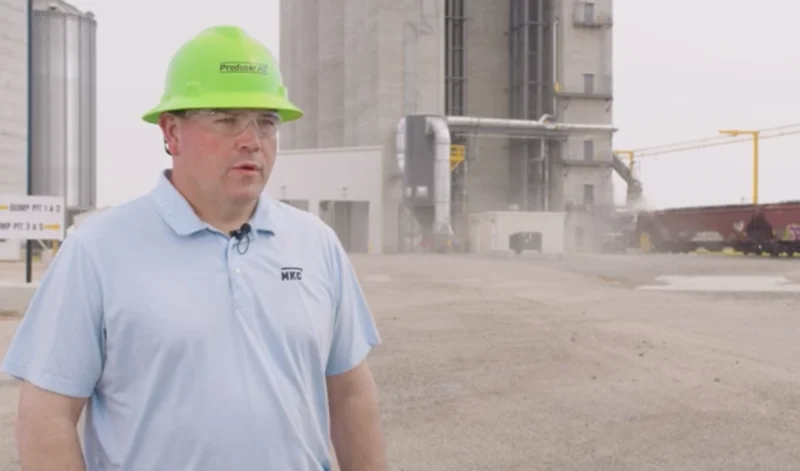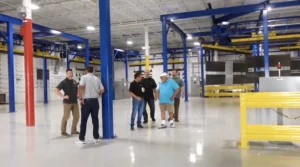Industry 4.0 by 2050
Job security is top of mind for workers within the manufacturing space and that concern is growing with the increasingly prevalent AI and IoT technologies that are changing the manufacturing landscape. The fear that robots will take over and annihilate the need for people continues to dominate conversations regarding automating manufacturing processes.
The reality – the world is changing and the need to re-imagine supply chains is more complicated than ever. Will robots take over as apocalyptic movies have bred fear for decades or will they support emerging needs in an ever more complex global society?
What is Industry 4.0?
Mike Wilkinson, GM & VP at Paragon Innovations which designs and engineers products for its clients, provides insight into where manufacturing companies have been and where they are potentially headed. To truly understand the current state of affairs, it’s paramount to understand where the manufacturing industry has been. Following is a brief history of the manufacturing industry as explained by Wilkinson:
- Industry 1.0 – In the beginning, factories were created to make handmade items automatically using machines.
- Industry 2.0 – The first major evolution came with the addition of railroads and the telegraph which facilitated national communications and the ability to move products and people faster throughout the US.
- Industry 3.0 – Manufacturing is once again upgraded by the addition of the computer which provided better communication tools, enabled improved operational processes, and increased personal productivity.
- Industry 4.0 – Where the industry is now with no clear definition at present as the reality of Industry 4.0 is still emerging. However, it is generally recognized that it is the implementation of advanced manufacturing technologies including IoT, AI, and 3D additive manufacturing that makes processes and outcomes more efficient, more automated, and more advanced.
With the increased automation, fears have risen once again about robots taking people out of the workforce. However, there are many layers to the complexities and outcomes of further automating manufacturing processes including an increased ability to bring manufacturing operations back to the US.
A Brief History of Offshoring Manufacturing Operations
To truly understand the complexity of nearshoring operations, it’s helpful to know why US manufacturing operations went global and what the economic impact has been over time. It all started in the early 1990s shortly after the Cold War ended in Dec. 1991.
“The hypnosis at the time was that nations that do trade, do business together will not fight each other,” noted David Beaird, President, Beaird Supply Chain and Operational Solutions. Beaird further explained that the thinking at the time was that countries would be intertwined with each portion of the planet specializing in something and America would specialize in service and consumer economies.
As of 2022, the global supply chain has evolved to fulfill the initial goals of bringing the world together through manufacturing. It has not, however, unilaterally prevented conflicts between countries. In fact, conflicts such as the 2022 Russian invasion of Ukraine can seriously impact supply chain operations and derail a company’s ability to produce necessary products.
The Argument for Bringing Manufacturing Back to the U.S.
There’s no question that people want to bring manufacturing jobs back to the U.S., but are they willing to accept the consequences of doing so? Not only would it require years of effort to bring operations back, but it would also have multiple consequences including an increase in the cost of goods.
However, the Covid-19 pandemic brought supply chain issues into everyone’s homes for the first time in modern history. Everything from toilet paper to pet food, bread to dairy products, and hand sanitizer to medicine quickly disappeared from store shelves leaving Americans to suffer through the unfamiliar landscape of product shortages.
Worse yet, even health care workers were unable to get the equipment they needed to provide the highest level of patient care. The reality is that U.S. dependence on other nations to meet daily living and healthcare requirements puts lives in jeopardy.
Nearshoring Supports a More Efficient U.S. Supply Chain
Saving money and reducing consumer costs are primary drivers for companies to utilize offshore resources to meet production needs. But what if it is possible to bring manufacturing operations to North America and keep the cost of goods and services down?
Nearshoring, the practice of keeping operations on a single continent, coupled with an increase in automation is an increasingly popular solution. Nearshoring shortens the supply chain, reduces transportation costs, increases business oversight of product quality, and provides companies with the opportunity to support a positive work environment.
“We have things that require labor to put together and offshore labor tends to be still less expensive,” explained Wilkinson. Less expensive labor can be found closer to home in many South American countries. And automation allows for more US-based jobs. “The more we can get the manual labor out of things using automation, using IoT, using data, we will get things reduced in cost and therefore more onshoring,” continued Wilkinson.
Smart Manufacturing Can Bring Jobs Back to the US
Smart manufacturing creates production lines that are flexible enough to make multiple products because they are more customizable. Combining automation, 3D printing, and robotics opens up endless possibilities including manufacturing at the point of need. For example, just imagine a hospital being able to make surgical equipment on location as needed.
This is a possibility that exists not too long in the future. Kosten Metreweli, Co-founder and CSO at Sunlight.io explains smart manufacturing as “a transformation in the way manufacturing operations work by making factories heavily, real-time data driven. Processes are heavily automated and can autonomously make decisions without the need for human interaction.”
These advancements lead to a reduction in the negative effects of labor shortages, more efficient processes, increased flexibility, better preventative maintenance, and cost reductions. It’s supports “a reevaluation of the need to offshore so much manufacturing if you can deliver a price point that’s close enough though with better quality, better customization and without the 3-week lead time of shipping from China?” continued Metreweli.
The Role of IoT in Nearshoring Manufacturing Operations
IoT is critical to creating smart manufacturing facilities that support job growth, shorten the supply chain, increase product availability, improve safety, and facilitate cost-effective product development. But what is IoT exactly?
Dan Allford, President at ARC Specialties who has worked in manufacturing for decades breaks the concept down simply stating that IoT “sounds like a robot… That’s what we’ve been doing all along. A robot is nothing but a control system with a bunch of sensor inputs and a bunch of outputs.”
“Robotics and IoT enable businesses to move dangerous and potentially harmful production activity to a robot or other automated technology – protecting our most valuable resources – our people. Additionally, robots are better suited to do precision work and repetitive tasks,” explained Barry Turner, Technical Business Development Manager at Red Lion.
According to Allford, robots will have “more sensors, more control power, more inputs, more outputs, more functionality. So, to me, that is the Internet of Things. We’re making machines better to do more.”
“That’s the trend – it’s called progress!” exclaimed Allford
So? Will IoT and Robots Bring Jobs Back or Take Away Opportunities?
Smart devices streamline communications, increase process efficiencies, and protect employees from dangerous work tasks. They replace human capital in performing certain activities while creating job opportunities. After all, the technology does not create itself nor can it function without human involvement.
At the end of the day, there is no real way to know what manufacturing will look like in 2050. Is it the frightening post-apocalyptic world run by robots envisioned by popular media? Or is it a world where people are enabled to maximize their potential while providing new opportunities for growth?
What is clear – IoT technologies are here to stay. As for how they will evolve and influence the world of manufacturing, only time will tell.








